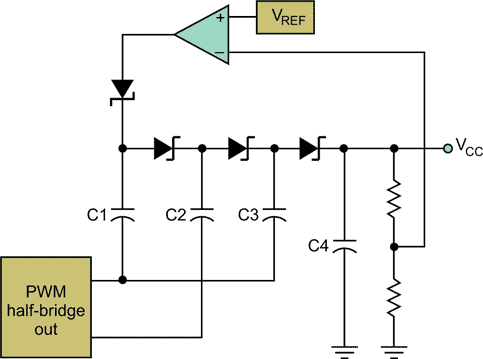By Keith Curtis Microchip Technology
For a recent project, I needed a regulated 15-V power supply capable of delivering a couple of milliamps. But the raw supply voltage to the circuit was only 9 V, and I didn’t want to add the expense of an inductive boost. I considered using a capacitive voltage doubler on the raw supply, but that would have required another IC on the board, and voltage doublers tend to sag badly under load.
What I really wanted was a simple circuit that used a handful of discrete parts and some of the leftover peripherals in my microcontroller. I went back to my microcontroller to see what peripherals I had left over. There was a pulse-width modulator (PWM) with various H-bridge output modes, a voltage comparator, a bandgap reference, and a few analog-to-digital converter (ADC) channels.
Early television designs used a simple capacitive-based voltage multiplier to generate the high voltage needed for the CRT. The circuit was called a Villard Cascade Voltage Multiplier and was essentially a slightly more complicated version of the voltage doubler or charge pump. By using my microcontroller peripherals to regulate charge transfer among various capacitors, I could use that same approach to generate a regulated 15 V from my 5-V supply. Combining the Villard multiplier topology with the PWM produced a circuit that could generate 18 V unloaded, and the comparator and bandgap provided a simple feedback mechanism (see the figure).
 |
| This cascade voltage multiplier uses microcontroller peripherals and a few components to generate a low-current, 15-V regulated output. |
When the bridge output voltage is low, the comparator charges the first capacitor (C1) for half a cycle, the anode reaching about 4.5 V (comparator output less the diode drop). On the other half of the cycle (output high), the cathode of C1 goes to 5 V so the anode is at 9.5 V and the charge in C1 transfers to the capacitor C2, bringing C2’s anode to 9 V.
Similarly, during the output-high half of a cycle, C2’s anode rises by 5 V, transferring charge to C3. During the low half, C3 transfers charge to C4, each stage about 4.5 V higher than the previous stage.
When VOUT is high enough that the voltage divider feeding the comparator’s negative input reaches VREF, the comparator output goes low. With the comparator output low, C1 does not charge, and charge propagation through the stages stops.
I tried this circuit using Schottky diodes for their low forward voltage drop and values of 0.1 µF, 1.0 µF, and 10.0 µF for the capacitors (all capacitors the same). I could regulate the output down to 15 V, based upon voltage feedback, by switching the PWM outputs on and off. The amount of current the circuit could deliver to the load varied with capacitor value, but all worked for my need, which was 1 mA or less.
